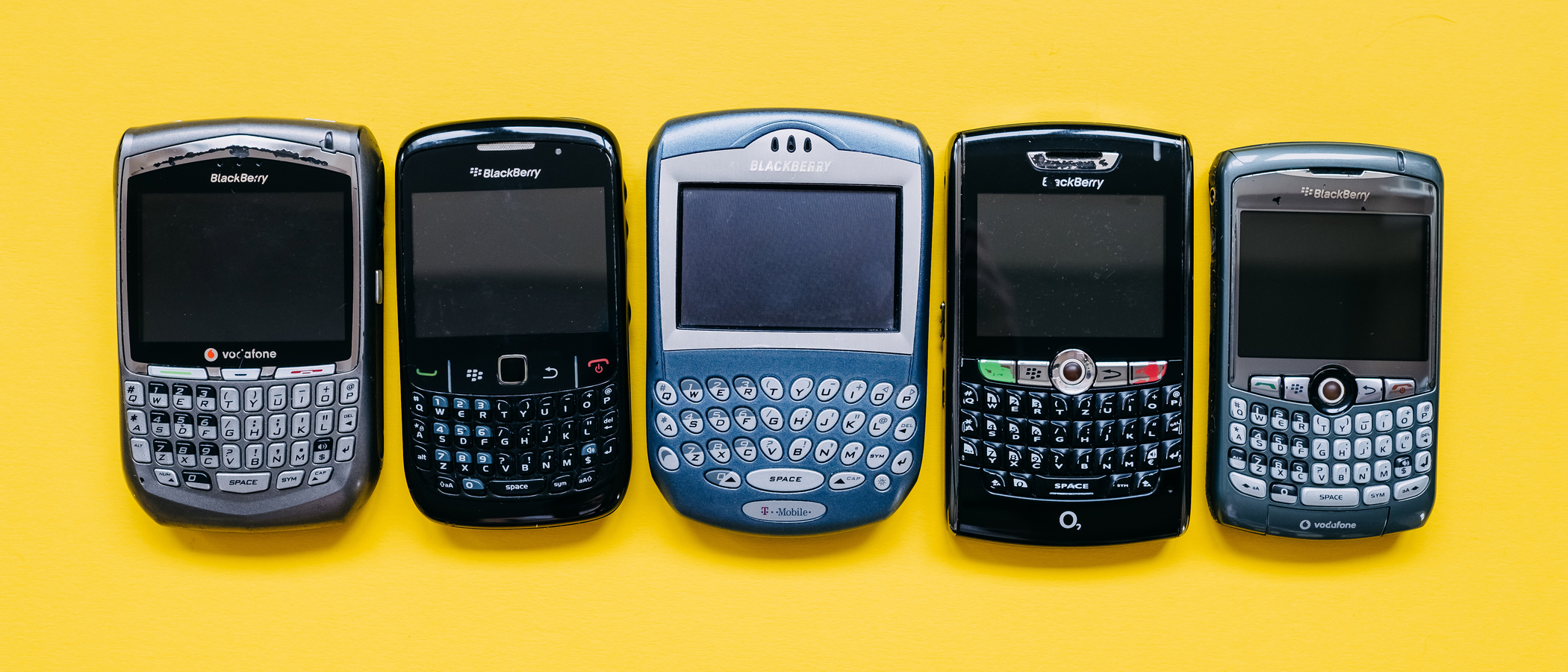The transformation of BlackBerry from mobile heavyweight into something else entirely
Few companies have undergone a change of identity like BlackBerry

Many people know BlackBerry as the company behind the iconic range of mobile devices, which were as beloved among regular consumers as they were the professionals they were built for.
However, BlackBerry hasn’t been a hardware company for more than half a decade now. Although the firm has licensed its branding to other manufacturers, it hasn’t launched a smartphone of its own since 2016.
The company also recently killed off BlackBerry OS, rendering a host of older devices unusable, and sold off a range of legacy patents relating to its phones and other technologies.
Instead, the modern BlackBerry is all about software and cybersecurity. The firm’s primary source of revenue is a line of services that help secure mobile devices and various other endpoints, and software that enables rich functionality inside connected vehicles.
According to Sarah Tatsis, an executive who has spent more than twenty years at BlackBerry, the pivot away from hardware was more natural than it might appear.
“There were quite a few challenges, because it was a big transition, but there was also a lot of opportunity,” she told TechRadar Pro.
“From the beginning, there has always been a focus on cybersecurity at BlackBerry. We’ve always thought a lot about how to move data through our infrastructure in a secure way. And that know-how is applicable across many different spaces.”
Are you a pro? Subscribe to our newsletter
Sign up to the TechRadar Pro newsletter to get all the top news, opinion, features and guidance your business needs to succeed!
The fall from grace
At the peak of its powers around 2010, BlackBerry held more than 40% of the mobile device market in the United States and roughly 20% of the global market, Comscore and Statista data shows.
This level of ubiquity was thanks in part to the quality and design of the devices – the Pearl, Curve and Bold series were all hits – but also to exclusive services like BlackBerry Messenger (BBM), access to which became something of a status symbol.
BlackBerry should also be recognized for its role in driving forward the remote working revolution. The company’s devices were among the first to allow users to browse and respond to emails on the move, which had the effect of unshackling professionals from their office computers.

The arrival of the iPhone in 2007 is often said to have marked the end for BlackBerry devices, but the company was actually able to hold its own for a number of years after iOS and Android rose to prominence. In other words, people were still content with their BlackBerry hardware.
According to Tatsis, the company’s fall from grace had more to do with software. The most significant mistake, she says, was BlackBerry’s failure to establish a marketplace for third-party applications, like the Apple App Store or Google Play Store.
“The key problem was the lack of applications available on our devices versus others at the time. We didn’t have the platform that a large application ecosystem provided,” she explained.
In 2015, BlackBerry eventually moved its phones over to Android in an effort to rectify the dearth of apps, but by that time its competitors had muscled their way into favor.
But there were other mistakes, too. For example, the company stuck doggedly to the physical keyboards for which it was best known, underestimating the flexibility of the touchscreen and value of the additional screen real estate.
BlackBerry was also insistent on maintaining its focus on the business market, despite the broad appeal of its devices. Although BlackBerry phones remained popular among businesses and government agencies, pressure from workers to support iOS and Android devices ultimately forced the hand of IT departments.
Squeezed out of its main market by new players who had more accurately identified the areas of opportunity, BlackBerry was left with no choice but to pivot.
The rebirth
The switch from hardware to security was the brainchild of John Chen, who took on the role of CEO at BlackBerry in 2013.
When it was first announced that the company would exit the hardware business, Chen unveiled a three-pronged strategy; BlackBerry would licence its branding, embed its technology into non-BlackBerry smartphones and extend its software to help secure the growing number of IoT endpoints.
As it transpired, the third of these objectives became the foundation for the new-look BlackBerry. Following the acquisition of security company Cylance, renowned for the quality of its AI-based solutions, in 2019, BlackBerry threw its weight behind its cybersecurity business with even greater conviction.
Today, the company offers a dizzying selection of endpoint protection and mobile device management services that utilize AI techniques to help companies protect against sophisticated cyberattacks.

It also runs a threat intelligence operation that analyzes developments in the threat landscape, from the latest malware strains to state-sponsored espionage activity. BlackBerry says the objective is to maintain an up-to-date picture of the kinds of threats its software needs to shield against, and to collaborate with the security ecosystem in support of shared goals.
Although Tatsis has held many roles in her two decades at BlackBerry, her latest position seats her in the IoT segment of the business, as SVP IVY Platform Development. Separate to the security services arm, her focus is on “building the foundational software that enables endpoints in a secure and scalable way,” she explained.
The IoT segment’s most well-known offering is BlackBerry QNX, which is now embedded in almost 200 million connected vehicles, from the likes of BMW, Volkswagen, Mercedes and Ford. The platform powers functionality ranging from safety and driver assistance systems to infotainment, in-car acoustics and more.
The IVY platform operates in a similar space, “focusing on enabling automotive OEMs to bring to market new experiences for customers”, says Tatisis.
Co-developed with AWS and currently in early access, IVY connects up to various sensors within a vehicle (e.g. seat sensors, optical sensors, battery management systems etc.), then plugs the data it collects into machine learning algorithms that generate insights that help inform the driving experience.

For example, IVY is capable of using a combination of data feeds to identify precisely who is in the car, knowledge that unlocks a wide range of possibilities.
“If I have the insight that Sarah is driving the car, I can send that insight to an application that can provide a personalized driving experience,” Tatsis explained. “That could involve playing Sarah’s favorite music, adapting the predicted range based on her driving style and more.”
In another hypothetical scenario, IVY could detect that children are present in the car and nudge the driver to activate child-lock systems. Understanding that the car has multiple occupants, IVY could also send up a flag that permits the vehicle to use high-occupancy vehicle lanes (HOVs).
It’s easy to look back on BlackBerry’s legacy in mobile and wonder how the company ended up here, but there remains a thread that connects these latest pursuits to its origins: a focus on security.
By performing computation on the edge and transporting only abstract insights to the cloud, IVY is able to minimize the exposure of personal data and lay the foundation for next-generation experiences with security baked in.
Who needs hardware, anyway?
Few companies have undergone a change of identity as complete as BlackBerry’s. And even fewer have managed to do so successfully.
Although BlackBerry was forced out of the hardware business by a failure to follow the opportunity, Tatsis believes the company is now ideally positioned to capitalize on the direction of travel.
With the number of IoT devices and connected vehicles expected to continue to expand at an aggressive pace, both cybersecurity and advanced new functionality will feature at the top of the agenda, she suggests.
“As the number of endpoints and sensors grows significantly, so does the risk from a cybersecurity and privacy perspective,” Tatsis told us. “To enable the innovations and great new experiences we expect to come from these endpoints, it’s vital that they are able to operate in a secure manner.”
“We’re really excited about where we’re going as a business. It’s all about helping to innovate and create solutions that help people and businesses remain secure and productive. These two key areas of IoT and cybersecurity are really what will be needed in the future for many of these endpoints.”
- Also check out our list of the best antivirus services around

Joel Khalili is the News and Features Editor at TechRadar Pro, covering cybersecurity, data privacy, cloud, AI, blockchain, internet infrastructure, 5G, data storage and computing. He's responsible for curating our news content, as well as commissioning and producing features on the technologies that are transforming the way the world does business.